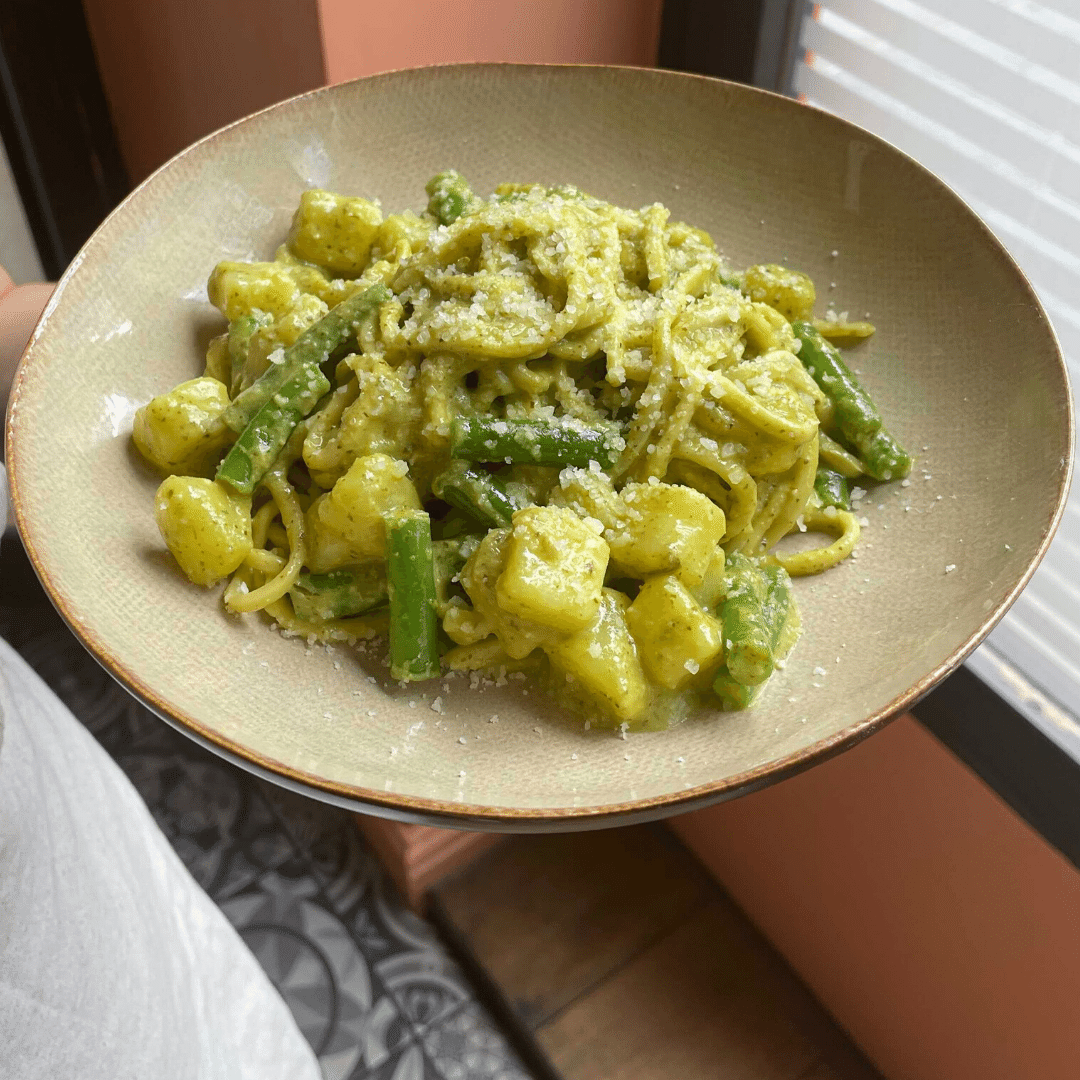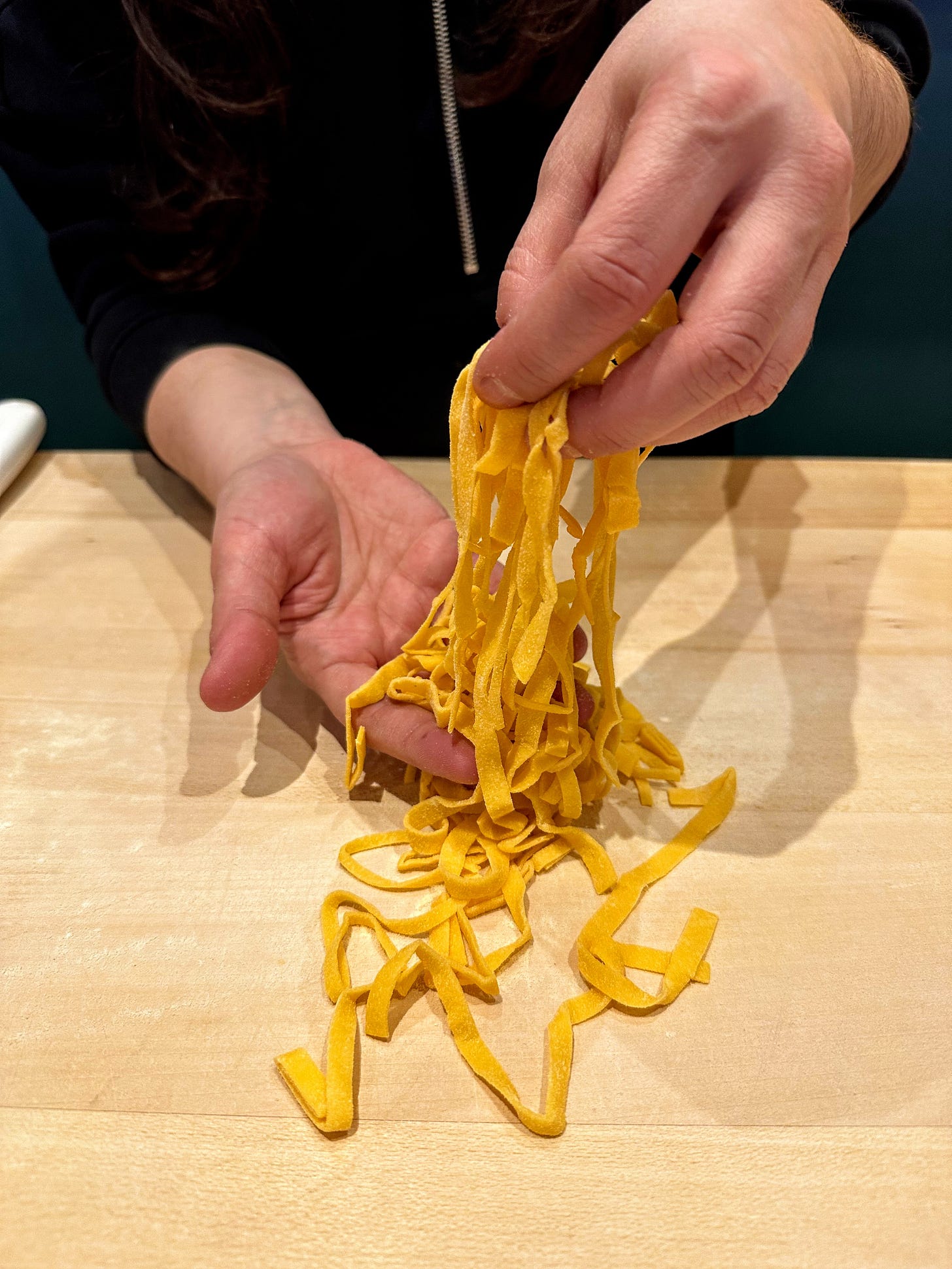Welcome to The Pasta Academy Newsletter, from Chef Roberta d’Elia and the team at Pasta Evangelists. Subscribe today to get the newsletter sent to your inbox every other Monday.
This week, we’re visiting the Italian Riviera – the setting for one of my favourite films: Disney Pixar’s beautifully animated coming-of-age story, Luca. If you haven’t seen Luca yet, I’d urge you to search it out. As well as being perfect for a lazy Sunday afternoon, I honestly think it’s required watching for anyone who loves Italy. With plenty of Vespa rides and evocative seaside scenery, it’s also the ideal balm as the darker nights creep in.
But onto the pasta, which appears by the bowlful. As well as being served plain for the film’s centrepiece pasta-eating competition, there’s one dish that crops up throughout Luca: trenette al pesto. A traditional specialty of Liguria, this dish pairs strands of trenette pasta with potatoes, green beans and a sauce of pesto alla Genovese. Ligurian tradition demands that the pasta, potatoes and green beans are all boiled together, which also has the handy effect of saving on the washing up.
Flat, long, and thin, trenette get their name from the word trena, which means ‘string’ in Genoese. The pasta itself looks very similar to linguine, although linguine is a little flatter, while trenette is a tad thicker and slightly more rounded. I’ve included instructions for making your own trenette from scratch, but feel free to use good-quality dried pasta instead. If you can’t find trenette, linguine will do just fine.
Trenette with pesto, potatoes and green beans
Serves 4
500g fresh trenette (instructions below) or 400g dried
100g green beans
1 large potato
50g fresh basil
2 cloves garlic
1 pinch coarse sea salt
2 tbsp Parmigiano Reggiano cheese
1 tbsp Pecorino Romano cheese
30g pine nuts
100ml extra-virgin olive oil
What you need
A large pestle and mortar (or food processor, see notes below)
A large mixing bowl, for tossing the pasta and pesto
The merits of pounding vs processing: The word pesto comes from the Genoese verb pestâ – pestare in Italian – which means ‘to pound’. Traditionally, the ingredients for pesto were always pounded in a marble mortar with a wooden pestle. But the arrival of food processors and blenders changed all that, and many Italians now eschew the traditional method for its speedier counterpart. Whilst chucking everything in a food processor is quicker, pounding the ingredients in a mortar will give you a pesto with a thicker, creamier consistency – one that clings to pasta much more effectively than pesto made in a machine. I’m definitely a traditionalist when it comes to pesto, but I’ve included both methods – so feel free to pick what works for you.
First, prepare your ingredients
Lightly toast the pine nuts in a dry frying pan, then remove and let them cool completely.
Peel the potato and cut it into small, 2cm cubes.
Wash and trim the green beans, then cut them into 3cm pieces.
Pick the basil leaves from their stems.
Peel and roughly chop the garlic cloves.
Finely grate both of the cheeses, either with a microplane or a box grater.
Next, make your pesto
Using a pestle and mortar:
Use the pestle and mortar to pound and grind the garlic and pine nuts into a paste, then remove the paste to a separate bowl.
Add the basil leaves and a pinch of coarse salt to the mortar and pound until the basil breaks down completely. If your mortar is small, you might need to do this in batches.
Next, add the Pecorino Romano and half of the olive oil and mix until combined.
Add the pine nut and garlic paste back into the mortar and pound until you have a thick green paste.
Add the Parmigiano Reggiano and the rest of the olive oil and mix until everything combines, you’re aiming for a creamy yet slightly chunky consistency.
Taste and add more salt if needed (go easy, you’ve already added a pinch of salt and the two cheeses, which are both salty).
Using a food processor:
Pulse the pine nuts, garlic and a pinch of salt into a rough paste.
Add the basil and a drizzle of oil, then pulse for a couple of seconds at a time until the basil breaks down.
Add the rest of the oil and give the mixture one last pulse.
Scrape the mixture into a bowl and stir both of the cheeses in with a spoon.
Taste for seasoning.
Now, let’s cook
Bring a large pan of water to a boil, add salt and give it a good stir.
Add the potatoes and set a timer for 15 minutes, stirring and letting them boil away happily for 3 minutes.
Next, add the green beans, making sure to stir again.
If you’re using fresh pasta, add it to the pan when there’s 4 minutes left on your timer. If you’re using dried pasta, add it when the timer matches the time on the packet instructions.
When the pasta, potatoes and beans are cooked, drain them, making sure you reserve some pasta water.
Scrape your pesto into a mixing bowl, then add your drained pasta and vegetables. Toss together until the sauce is evenly distributed, adding more pasta water to help it emulsify.
To serve, transfer to a plate and top with a few more basil leaves and a generous grating of parmesan or pecorino. Buon appetito!
How to make fresh trenette
What you’ll need
1 batch egg pasta dough
A clean work surface, ideally wooden
A rolling pin, or a pasta machine
A sharp knife, or a trenette pasta machine cutter attachment
A flat baking tray, for holding the finished pasta
Semola flour, for dusting.
With a pasta machine:
Set up your workspace: Once your dough has rested, lightly dust your work surface and the baking tray with a little semola flour. Set up your pasta machine, clamping it to a table, countertop, or sturdy cutting board. Set the dial to its widest setting (setting 0 on my machine).
Shape the dough: Cut off half of the dough and re-wrap the remainder. Place the piece of dough on your floured work surface, then use the heel of your palm to flatten it into an oval that’s about half a centimetre thick.
First roll: Place the narrow end of the oval in the centre of your pasta machine slot and roll it through once – you should be left with a longer, thinner oval.
Fold and roll again: Lay your oval on your floured work surface, then fold it so the narrow ends meet, pressing down with your hands to flatten it. Pass the folded piece of dough back through the pasta machine at the same setting, repeating the process three times in total.
Work through each setting: Move the dial down to the next setting and roll your sheet through it once. Repeat this process, rolling your dough through the machine one time on each setting, until you have a thin but sturdy sheet that’s about 3mm thick (I go up to and including setting 4 on my machine). If need be, dust the sheet of dough with flour to prevent it from sticking to the machine. You now have your sheet of fresh pasta dough.
Dry (and repeat): Leave the sheet to dry on your flour-dusted baking tray, then repeat the process with the other piece of dough.
Cut the pasta: If your pasta machine has a trenette or linguine cutter attachment, feel free to use that. Alternatively, follow my instructions for cutting trenette by hand, which follow the rolling pin method below.
With a rolling pin:
Set up your workspace: Once your dough has rested, lightly dust your work surface and the baking tray with a little semola flour.
Shape the dough: Cut off half of the dough and re-wrap the remainder. Place the piece of dough on your floured work surface, then use the heel of your palm to flatten it into a rough circle.
Roll the dough: With a rolling pin, begin rolling the dough as you would pastry crust, starting in the centre and rolling away from you to the outer edge. Turn the dough a quarter-turn, and repeat, working your way around, until the sheet of dough is about 3mm thick. Scatter a small amount of flour on the dough whenever it starts to stick to the surface or the rolling pin. You now have your sheet of fresh pasta dough.
Dry (and repeat): Leave the sheet to dry on your flour-dusted baking tray, then repeat the process with the other piece of dough.
Cutting trenette by hand
Place your sheet of dough lengthwise onto your clean, lightly floured work surface, trimming the shorter ends with a knife so that they’re straight.
Starting at the short ends, begin folding each end into the centre at two finger intervals, sprinkling extra semola after each roll. You should end up with a tight scroll of pasta.
Using your knife, cut the package vertically into 3mm strips, keeping your cuts steady and decisive.
Slide your knife under the the scroll of pasta, so the spine is roughly aligned with the line that separates the folded scrolls of pasta.
Lift the knife and let the strands of trenette unravel, giving them a gentle helping hand with your fingers if they don’t immediately unravel.
Toss the strips of trenette with some semola to ensure they don’t stick, then gently lift them into the air and arrange into loose nests on your flour-dusted baking tray until you’re ready to cook.
Thanks for reading The Pasta Academy Newsletter, from Chef Roberta d’Elia and the team at Pasta Evangelists. Subscribe today to get the newsletter sent to your inbox every other Monday.












